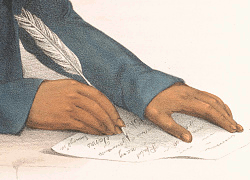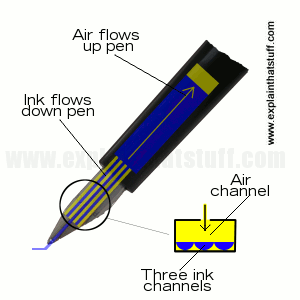
Fountain pens
by Chris Woodford. Last updated: February 16, 2023.
Will there come a time when handwriting is completely obsolete? It just might happen! Most of us write far less than we used to: we laser print documents typed on our computers, pay for things by swiping credit cards past a machine (where once we'd have written checks), and even send our most personal thoughts to other people by email, instant message, or SMS (text message). If you're lucky, you might still get letters and greetings cards in the mail that have been written out by hand. And if you're super lucky, they might have been lovingly handwritten with a fountain pen—probably the most individual and expressive instrument you can use for sending a written message to another person. How exactly do these ink-scribbling machines work? Let's take a closer look!
Photo: The gold nib of a Waterman ideal fountain pen.
Sponsored links
Contents
What is a fountain pen?
Writing technology is still much the same as it was several thousand years ago: the basic idea of making your mark with some kind of pigment (a color chemical used in inks, paints, and dyes) remains as valid today as it was to our ancestors.

Illustration: Before fountain pens came along, many people wrote with sharpened feathers called quills. This is the scribbling hand of John Ridge, a Cherokee, pictured c.1838 in a lithograph by John T. Bowen, courtesy of US Library of Congress.
Some things have moved on: instead of scratching words with reeds or quills made from bird feathers, most people opt for inexpensive, plastic ballpoint pens. These use a relatively viscous (thick and sticky) ink supplied from a thin tube that dries almost as soon as it hits the page. Some people prefer fiber tips, a relatively recent invention (developed by Yukio Horie of Pentel in the early 1960s), in which a soft plastic point drags a liquid or gel ink from a sponge concealed in the main tube of the pen. But people who really want to leave their mark choose a fountain pen, which uses a much more runny liquid ink. It's very easy to make a mess with ink like this—and that's why the design of the pen is particularly important.
Fountain pen parts

Photo: A closeup of a typical fountain pen nib. Note the grooves of the plastic collector underneath the metal nib. The feed passes through the center of the collector and the wider black tube on the right, which is the bit your fingers hold and is known as the section.
A fountain pen has four key parts:
- The reservoir (the ink tube concealed in the pen's handle).
- The nib (the pointed metal end that you drag over the paper).
- The feed (a plastic tube with three thin channels running down inside it that connects the nib to the reservoir).
- The collector (visible as a set of grooves or fins just beneath the nib, this part of the feed collects ink flowing from the reservoir and stops too much flooding out at once).
There are a few other less essential bits and pieces too. There's a cap that conceals the nib when the pen's not in use and stops the ink leaking into your coat. Usually the cap has a clip on it so you can wear the pen safely in your pocket. There's a protective outer case called the barrel, covering the reservoir at the opposite end, often made from a highly attractive material coated with lacquer. In most fountain pens, the reservoir is either a refillable plastic tube (with a miniature piston/plunger mechanism inside it for drawing in ink from a bottle) or a disposable ink cartridge.

Photo: A lacquered Waterman Ideal pen with a silver Sheaffer underneath.
How does a fountain pen work?
Crudely simplified, a fountain pen is a bit like a bottle filled with blue or black water. Imagine trying to write something with a bottle of water and it's easy to figure out the science of how a fountain pen works. Suppose you take the top off a full water bottle, tip it upside down, and try writing your name with it. What happens? The water floods out rapidly—glug-glug-glug!—in about 10 seconds flat and soaks your page, the desk, the floor, and everything else in sight. The "glugs" aren't me trying to be funny: they're important—and we'll come back to them in a moment.
The power of pressure
What if you modified the water bottle so, instead of a relatively large open neck, it had only a tiny hole at the top? You can try this for yourself. Go to a bathroom or kitchen where you can safely make a mess. Take an old drinks bottle with a plastic lid, fill it with water, and screw the lid on tight. Now make a small hole in the lid with a pin and turn the bottle upside down. You'll find the water doesn't come out at all (or if it does, only incredibly slowly). The reason is simple. Despite the weight of the water pushing down, air pressure is pushing up in the opposite direction and stopping the water from leaving the bottle. The air acts a bit like a finger pushing up and blocking the hole! If you now make a second small hole in the top of the bottle (the end that's up in the air, opposite the lid—the end that's normally the bottom of the bottle), you'll find the water starts to come out, as you'd expect. Air can enter the top of the bottle and that allows water to escape from the bottom. Cover the air hole with your finger and you'll stop the water flowing out; open the air hole and the water drips out once again.

Photo: You might think I'm emptying water from this bottle, but you could also see it the opposite way: I'm filling it with air. If air were visible, you'd see it rushing into the neck of the bottle past the line of water rushing out. The water can only get out if the air can get in. Exactly the same principle applies to a fountain pen.
Ink out, air in

Photo: Look closely at the nib of a fountain pen and you'll see it's split in two. When you use a pen like this, you can often see a line of ink flowing down the slit from the feed by the process of capillary action. If you look again at the first photo on this page, you'll see the light blue Pelikan pen in the center has a visible line of ink along the slit in its nib. Some pens (but not this one) have a large "breathing" hole at the top of the slit to allow air into the pen.
Now most of the time, we can tip water from a full bottle without making a hole in it... so how does that work? Try it and see. Fill a water bottle and then invert it. Instead of draining smoothly and cleanly, you'll find the water leaves in jerky glugs, with huge air bubbles forming and rushing up through the water from the bottom to the top. What's happening is that air has to enter the bottle as water leaves, so there's a constant fight at the neck between air going in and water coming out—and that's what makes the glug-glug-glug noise. If you tilt the water bottle more toward the horizontal and tip the water out at a shallow angle, the air can enter at the same time as the water leaves, without them fighting over the neck, so the glug noise disappears.
How does all this relate to a fountain pen? You can probably see now that the mechanism of a fountain pen is as much about letting air in as letting ink out. The feed incorporates a system of parallel channels, three small ones for ink and one big one for air, so air can flow upward into the reservoir as ink flows down toward the paper at a carefully controlled rate: you get just enough ink to make a good, solid line, not so much that you flood the paper, and not so little that the pen doesn't write at all.
Gravity and capillary action
When you write with a fountain pen, how does the ink get from the reservoir onto the page? It flows partly through gravity (its own weight pulls it downward), but also through capillary action (the phenomenon where a liquid will automatically draw itself along a very thin tube—which is how water rises inside a plant). If you hold a fountain pen with the nib pointing straight down, gravity doesn't make the ink all pour out, as you might expect. That's because the feed linking the nib to the reservoir is quite narrow. In effect, we have a situation like the plastic bottle filled with water with a tiny hole punched in the lid: ink can't escape from the fountain pen because air can't get in.

Artwork: This is roughly how the fountain pen feed works: it's a bit like a small pipe with three tiny ink channels running at the bottom of it and a bigger air channel right above them. As ink runs down the three ink channels, air enters the pen and runs past it, above it, in the opposite direction. The inset diagram on the right is looking at a cross-section of the feed (looking straight up the nib).
So how does the ink get out? When you put the nib on paper and drag it along, the ink is pulled down a slit in the center of the nib, and down the feed, by capillary action. That means it's pulled partly by the adhesive forces between the ink and its container (the slit in the nib and the three little channels in the feed) and partly by the cohesive forces between every ink molecule and the ones following on behind it). More ink then flows down the feed from the reservoir to take its place. Think of it this way if you prefer: as each ink molecule hits the paper, it drags on the molecules that are just inside the nib, tugging on them as though they were linked by a chain, and eventually pulling ink from the feed and the reservoir. Air enters the pen at the same time through the slit in the nib, and moves in the opposite direction, gradually filling up the reservoir as it empties of ink.




